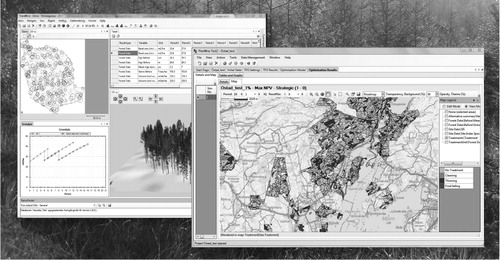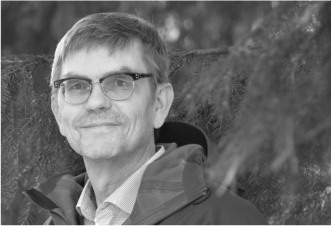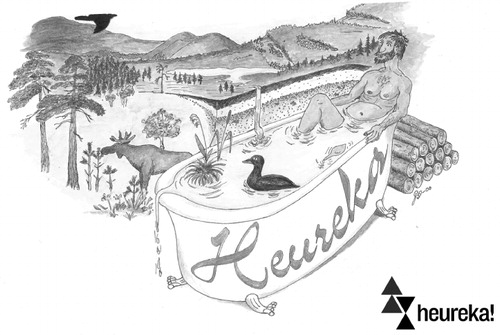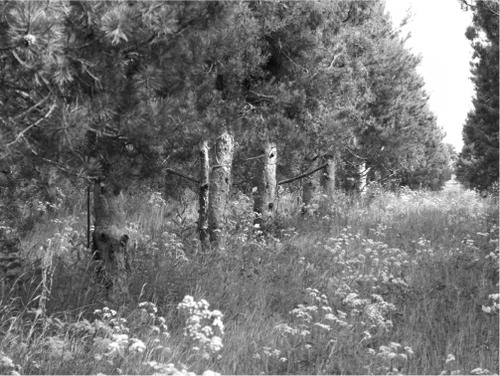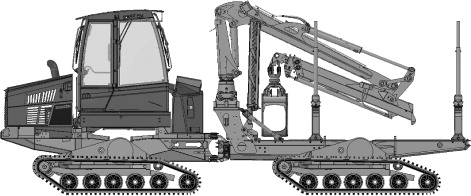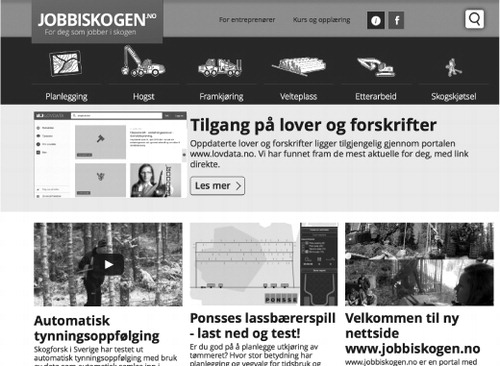Left: A result from StandWise with data about the stand and a 3D-view. Right: Suggestions from PlanWise for the first five-year period: Precommercial thinnings (yellow), thinnings (dark green) and final harvest (red). Background photo: Areca
The Swedish planning system Heureka expands abroad
The decision support system Heureka is internationally renowned for its complete set of software relevant to all kinds of forest planning. The system, developed by researchers in Sweden, has attracted the attention of Nordic neighbours. A project is currently underway to introduce Heureka in Norwegian forest planning.
– A single tool that combines economics, ecology and social values – a unique concept. Tomas Lämås. Photo: Mona Bonta Bergman.
– The project “Sustainable utilization of forest resources in Norway” is a collaboration with SLU, and implementing Norwegian growth and yield models in Heureka is one part of the work. Cooperation will intensify this year, and we hope that this can be another step towards projects with more countries, says Tomas Lämås, Programme Director of Forest Sustainability Analysis, the unit responsible for the maintenance and further development of Heureka.
Heureka consists of a set of software tools covering the entire analytical chain from different forest data sources, through predictive modelling and optimisation, to tools to rank alternatives (see next page).
– We are proud of the many options, the flexibility with respect to input data and the depth, which also allows detailed analyses of the effects of silvicultural activities, says Tomas Lämås.
Used in nationwide analyses
The combination of economics, ecology and social values in one tool is globally unique. Computer-aided decision support systems, of course, are not new, they have been developed along with the introduction of computers. For many years, Swedish researchers used Hugin, developed in the late 1980s, for a number of analyses. For example, the repeated nationwide forest impact analysis (SKA) used the Hugin system. But now, Heureka has taken over that role, says Tomas Lämås.
– The ongoing analysis, SKA15, will rely on Heureka. The Heureka system allows more in-depth analyses and more detailed estimates of the effects of new silvicultural methods compared with Hugin.
New silviculture
One new field is the analysis of continuous-cover forestry. Models to estimate growth in multi-layered forests with a large range of tree ages and species is a challenge.
– Currently, Heureka is the best tool for analysing continuous-cover forestry. But models are still being developed, and we will increase the effectiveness over time, says Tomas Lämås.
Heureka has been used in numerous research projects. The long list of publications shows that the tools are valuable outside traditional silvicultural and forest management planning research. Conservation biology and hydrology are some such examples.
Cooperation with IIASA
The Austrian-based International Institute for Applied Systems Analyses (IIASA) will use models from Heureka in a project focusing on economy and land use. The project will run IIASA's global models along with Heureka to calculate the future production of wood and other ecosystem services based on different scenarios for land use, climate change, population growth and policy development. The research program Future Forests is heading the Swedish part of the project.
User-friendly
A large number of Swedish forest companies use Heureka software in their operational and tactical planning. One example is SCA, which uses Heureka for analysing its entire forest area. Field plot data were assembled over 2 years, and the information has been used to calculate harvest potentials and to rank stands. Heureka will be used to forecast the future forest condition, and the plot information will be linked to LIDAR data.
– We have found that Heureka is both stable and user friendly, says Håkan Johansson, planning specialist at SCA, on the Heureka webpage.
Holmen, Sveaskog and Skogssällskapet are other companies that use Heureka.
The Heureka tools can optimise forestry to meet targets relating, for example, to social values or biodiversity. Skogssällskapet (the Swedish Forestry Society Foundation) has used it to plan silviculture for a non-profit owner, a municipality, with high ambitions for social values besides economic outcome.
Available in English
The Heureka user-interfaces, help documentation and a technical Wikipedia are available in English, which allows international researchers to use the program and access the help functions.
– Heureka is a top decision support system, internationally. It is thus important that the content is transparent for researchers from all around the world, says Tomas Lämås.
Read more:
www.heurekaslu.org and www.slu.se/sha
Contact: [email protected]
A set of models
The Heureka system consists of the following software
StandWise: For stand-level analysis, with 2D and 3D visualisation. StandWise is an interactive simulator in which the user specifies treatments period by period.
PlanWise: For forest-level and landscape planning. Enables exploration of many different management options and has an inbuilt optimiser for solving problems. Includes a report builder for maps, tables and charts.
PlanEval: An application to compare and rank the plans created in PlanWise.
RegWise: Evaluates impact at the regional level. Hugin's successor.
Heureka Habitat Model: An ArcGIS application that reads data from PlanWise or RegWise, determines which stands are suitable for a set of species in each planning period, and saves the information in a format that can be returned to PlanWise and RegWise.
According to Wikipedia, “Eureka” comes from the Ancient Greek word heúrēka, meaning “I have found (it)”, which is the first person singular perfect indicative active of the verb heuriskō “I find”. It is closely related to heuristic, which refers to experiencebased techniques for problem solving, learning, and discovery.”
The exclamation “Eureka” is famously attributed to Archimedes when he stepped into a bath and noticed that the water level rose. The Archimedes story inspired the artist view of the research. Illustration: Gunnar Odell.
Shortcuts
Sweden
National Forest Programme is also on the way in Sweden
News & Views has reported about the recently released National Forest Programme in Norway (SKOG22) and Finland has its “Finlands Nationella Skogsprogram 2015”.
Sweden has been lagging behind, but work is going on. The process was launched in 2012, and the Swedish Forest Agency undertook a feasibility study emphasising the process in itself and the content of the programme. That study attracted the attention of a large number of stakeholders, who sent in their comments for consideration.
There was a hiatus in the programme in 2014 due to a change in government. In early 2015, the new Minister of Rural Affairs Sven-Erik Bucht started up the new process. A working group will be established that will produce reports in fields such as Sustainable growth and work, Forestry and climate, Biodiversity and ecosystem services, Social values and Wood in house-building. The reports will be presented in December 2015.
The whole process will probably take another couple of years before Sweden also has its own national forest programme.
Sources: www.regeringen.se, Sveaskog, Future Forests
Sweden
Military technology minimises soil impact
Skogforsk is currently evaluating a new concept for a track-driven forwarder. The machine is based on a traditional forwarder equipped with tracks from military vehicles. The purpose of the new machine's design is to minimise soil damage, improve the operators environment and increase productivity.
The project is being run in a collaboration between Skogforsk, BAE Systems Hägglunds, Komatsu Forest and SCA Forest.
Source: www.skogforsk.se
Picture: Skogforsk
Sweden
New tool for tree breeders
OPSEL is a new tool that helps tree breeders to select trees to use in breeding populations and seed orchards. The program is free to download from Skogforsk's webpage. An optimal selection takes into account both genetic diversity and genetic gain. The program has been developed by Tim Mullin, researcher at Skogforsk in Sävar.
Download OPSEL from www.skogforsk.se
Scots pine seed orchard. Photo Mats Hannerz
Finland
Hot water extracts xylan from birch
A new eco-friendly method can be used to extract xylan from birch sawdust. The method is based on pressurised hot water that penetrates the wood, and extracts and breaks down the hemicellulose collected during extraction.
Xylan is a hemicellulose compound which could be used, for example, in food product packaging that requires films and surfaces that are not oxygen-permeable. Xylan can also be used to produce Xylitol, a sweetener that is not associated with tooth decay.
The findings were presented by researcher Petri Kilpeläinen from Luke.
Source: www.luke.fi
Norway
Enzymes make trees digestible
Will we eat trees in the future? It is, at least, not impossible. Researchers at Norwegian University of Life Sciences (NMBU) have discovered new enzymes that can break down plant material more rapidly than has been possible to date. As a result, in the future, we may be able to eat currently non-edible plants and drink from plant-based soda bottles.
Bjørge Westereng, one of the researchers, explains that the newly-discovered class of enzymes can break down a wide range of plant cell material, including hemicelluloses.
Source: www.nmbu.no
Shortcuts
Sweden
Golden branches to researcher and research communicator
Guldkvisten (the golden branch) is presented each year to individuals who have made valuable contributions to Swedish forests and forestry. The award was presented by his majesty Prince Carl- Philip at the opening of Skogsnäringsveckan (forest industry week).
Golden branches were given to Professor Annika Nordin, leader of the research programme Future Forests, and Dr Mats Hannerz, research communicator and editor of the knowledge system Kunskap Direkt, which provides forestry advice for practitioners*.
A branch was also given to Katarina Levin, head of the sawmill Tunadal.
Read more: www.skogen.se
*He is, by the way, also editing News & Views!
Award winners, from left: Annika Nordin, Katarina Levin, HM Prince Carl Philip, Mats Hannerz, Leif Jougda, Daniel Eriksson.
McDonald's ends deforestation…
The fast food giant McDonald's has pledged to end deforestation across its entire supply chain. The announcement follows recent similar pledges by Dunkin’ Donuts and many others.
McDonald's promises not to contribute to deforestation in areas most critical to reducing carbon in the atmosphere. These are areas of high environmental value, including high biodiversity. In addition, it will not use sources from peatlands or swampy areas that store a lot of carbon. The decision will affect 3,100 of the company's direct suppliers and a more complex network of indirect suppliers.
Source: The Guardian
Norway
New webpage for forest entrepreneurs
The webpage www.jobbiskogen.no is a portal with links to facts, videos, calculators and research results relevant to machine operators in the forest sector.
The webpage has been developed and is operated jointly by Norwegian Forest and Landscape Institute and Skogkurs (Forestry Extension Institute). The aim of the webpage is to collate all important information in one site.
Read more about the project on www.skogoglandskap.no
…and Apple safeguards production forest
Apple has announced an initiative to conserve more than 36,000 acres (c.15,000 hectares) of forest land in Maine and North Carolina. The purpose is not to preserve them as unmanaged, but to ensure that they will continue to be used as timber forests. The initiative is a collaboration with The Conservation Fund.
Out of the 300 million hectares of forest in the US, about 170 million hectares are used for timber production. Many of these are in risk of being lost to development, for example by being converted into residential and commercial space.
Source: The Conservation Fund
Contact News & Views
Write to the scientific editor:
Mats Hannerz,
Silvinformation AB
More info about SNS:
News & Views is a newsletter from SNS containing short, popularized articles covering Nordic forest research and forestry. Articles presenting SNS-supported activities are prioritized. The newsletter is published eight times per year, and is available for download from the SNS and Scandinavian Journal of Forest Research websites.
News & Views is edited by Mats Hannerz, Silvinformation AB [email protected] and produced by Carl Henrik Palmér. [email protected]

